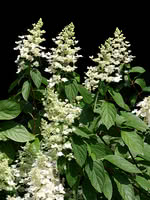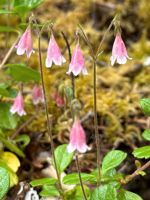Mon-Fri 9am - 5pm Mountain time
Phantom Hydrangea vs Twinflower
Hydrangea paniculata Phantom
Linnaea borealis
CUSTOM GROW
CUSTOM GROW
Phantom Hydrangea is a striking deciduous shrub with impressive blooms. It is multi-stemmed and produces pale green flowers that fade to white and soft pink as they mature. These flower clusters can reach up to 15” (40cm) long and while other shrubs will droop from the flowers' weight, Phantom Hydrangea has sturdy stems that support them.
This adaptable shrub will make a beautiful addition to your yard as a flowering hedge or as an ornamental plant on its own. Try pruning the flowers after they are spent to get even larger flower heads.
Twinflower is a native, trailing evergreen ground cover known for its delicate flowers that grow in nodding pairs. These pale pink blooms are described as being sweetly fragrant, attracting native bees and other pollinators.
Growing in cool, moist, acidic soils, the trailing stems form roots as they spread and start to form mats across the forest floor. Due to its woody stem, it is technically classified as a shrub and often referred to as a subshrub or dwarf shrub. This species is well-suited for naturalization, restoration, and conservation projects.
Twinflower (Linneae borealis) was named in honour of Carl Linnaeus, who adopted it as his personal emblem.

